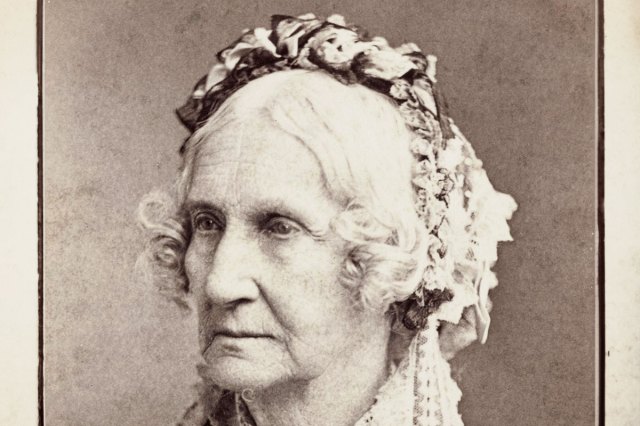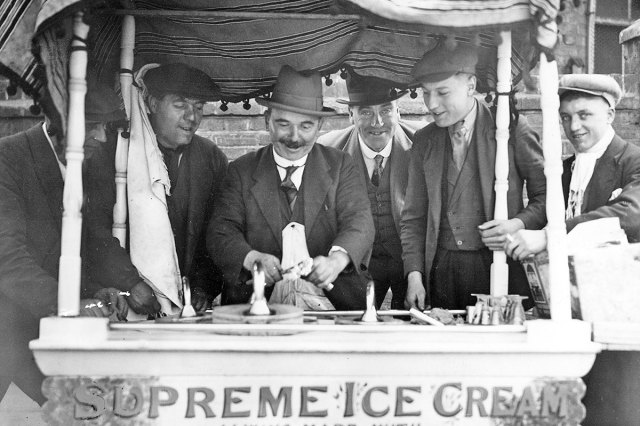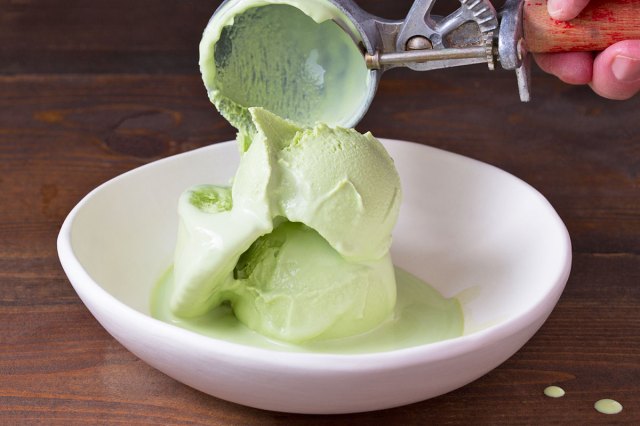
Ice Cream Is Thousands of Years Old
It’s hard to pinpoint the exact origins of ice cream, but treats made from snow have been popular for thousands of years. Alexander the Great and the Roman Emperor Nero were both said to enjoy snow flavored with sweeteners, including honey and fruit juices, while biblical passages refer to King Solomon enjoying “a snow-cooled drink at harvest time.” Dairy-based desserts, meanwhile, seem to have first developed in China during the Tang dynasty (618 CE to 907 CE). In the summer, Chinese nobility enjoyed milk ice, a treat made from a rice milk paste normally used to make rice pudding, and snow gathered from the mountains. Ancient records also describe a process of fermenting buffalo, cow, or goat milk that was then thickened with flour and flavored with camphor oil before being placed in metal tubes and frozen in an ice bath.

A Woman Invented the First Hand-Cranked Ice Cream Maker
Ice cream was served in the American colonies as early as 1744, and Thomas Jefferson is credited as the first known American to write down a recipe for it, but it took almost a century for someone to come up with a more efficient process of making it. In September 1843, Nancy Johnson received the first patent in the United States for an appliance to make ice cream. Johnson’s Artificial Freezer included similar components to manual ice cream makers of the time, with a lidded metal container fitted inside a larger pail and room for ice and salt to be placed in the space between the two containers. But Johnson revolutionized the design by including an exterior hand crank connected to interior perforated paddles. When the hand crank was turned, the paddles scraped the insides of the ice cream container, which not only reduced the prep time and labor involved in old-fashioned ice cream making, but also improved the texture of the final product.

Ice Cream Consumption Surged During Prohibition
In 1920, Congress enacted the Volstead Act, thus enforcing the 18th Amendment and instituting a federal ban on the manufacture and sale of alcoholic beverages. Prohibition, driven by decades of organized efforts on behalf of the temperance movement and the Anti-Saloon League, dealt a devastating blow to the alcohol industry but led to a surge in ice cream consumption. While many businesses didn’t survive the 13 years of Prohibition, some companies got creative and shifted to producing other goods, from nonalcoholic beer to ceramics. Breweries had large refrigeration facilities, which made it practical for them to pivot to the production of dairy products — including ice cream. Ice cream production helped companies such as Yuengling, Anheuser-Busch, and Stroh Brewery Company weather the economic storm of Prohibition while satisfying the nation’s growing demand for frozen treats.
More Interesting Reads

There’s a Scientific Reason Ice Cream Doesn’t Refreeze Well
Ice cream is an emulsion — a mixture of liquids that don’t normally combine together (similar to oil and vinegar) — that manages to combine due to its frozen state. The small ice crystals that develop when ice cream is blended are surrounded by air bubbles and fat, which is what gives ice cream its light and creamy texture. When ice cream melts, its molecular structure deteriorates and the ice cream destabilizes. This means those tiny ice crystals dissolve, releasing their stored sugars, and the air bubbles escape as the fats and proteins thin out, reverting to their liquid form. Melted ice cream that has been refrozen won’t return to its original consistency because of the loss of air bubbles and the formation of larger ice crystals with fewer sugars. The end result is a harder ice cream that may be icy, grainy, and not as sweet.

New Zealand Ranks No. 1 in Ice Cream Consumption
Americans are known to love their ice cream, but when it comes to ice cream consumption, the U.S. ranks second to New Zealand, whose citizens annually enjoy an average of 7.5 gallons of ice cream per person. Vanilla is the most popular ice cream flavor in both the U.S. and New Zealand (as it is in most countries), but chocolate takes the No. 2 spot in the U.S., while New Zealanders’ second-favorite flavor is hokey pokey. First invented in 1953, hokey pokey ice cream consists of a vanilla ice cream base with small bits of honeycomb toffee, known as hokey pokey, mixed in. The toffee itself existed long before the ice cream flavor’s creation, but the flavor may get its name from the slang term “hokey pokey,” used to describe a type of cheap ice cream sold by street vendors (often Italian immigrants) who were known as “hokey pokey men.” It’s thought that the term originated as a mishearing of the Italian phrases “ecco un poco” or “oh che poco,” both of which roughly translate to “a little piece.”











